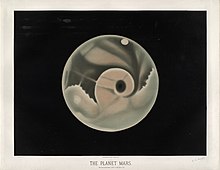History of Mars observation

The proven history of observing Mars goes back to the time of astronomy in ancient Egypt in the 2nd millennium BC. Chr. Chinese records of the movements of Mars appeared before the founding of the Zhou Dynasty (1045 v. Chr.). Accurate observations of the position of Mars were made by Babylonian astronomers who developed arithmetic methods to predict the future position of the planet. The ancient Greek philosophers and astronomers developed a geocentric view of the world to predict planetary motion. Measurements of the angular extent (including the apparent diameter) of Mars were already available in ancient Greek and Indian texts. In the 16th century, Nicolaus Copernicus proposed a heliocentric view of the world for the solar system, in which the planets orbit the sun in a circle. This model was modified by Johannes Kepler , which resulted in an elliptical orbit of Mars, which corresponded more closely to the data of the observations.
Individual evidence
- ^ Étienne Léopold Trouvelot: The Trouvelot astronomical drawings manual. Charles Scribner's sons, New York 1882, pp. 64 ff, ( archive.org ).